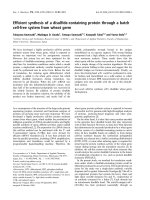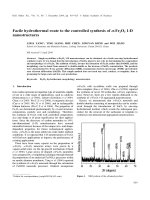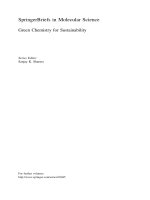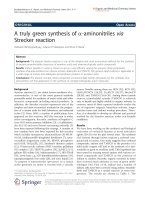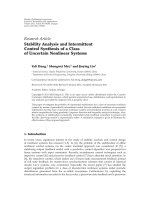Toward synthesis of a macrocyclic hybrid aromatic pentamer
Bạn đang xem bản rút gọn của tài liệu. Xem và tải ngay bản đầy đủ của tài liệu tại đây (2.08 MB, 38 trang )
TOWARD SYNTHESIS OF A MACROCYCLIC HYBRID
AROMATIC PENTAMER
SUN XIAONAN
NATIONAL UNIVERSITY OF SINGAPORE
2014
TOWARD SYNTHESIS OF A MACROCYCLIC HYBRID
AROMATIC PENTAMER
SUN XIAONAN
(M.Sc.) PKU
A THESIS SUBMITTED
FOR THE DEGREE OF MASTER OF SCIENCE
DEPARTMENT OF CHEMISTRY
NATIONAL UNIVERSITY OF SINGAPORE
2014
DECLARATION
I hereby declare that the thesis is my original work and it has
been written by me in its entirety.
I have duly acknowledged all the sources of information which
have been used in the thesis.
This thesis has also not been submitted for any degree in any
university previously.
_________________
I
ACKNOWLEDGEMENT
This paper could not be written to its fullest without Dr. Zeng Huaqiang, who served
as my supervisor, as well as one who challenged and encouraged me throughout my
time spent studying under him. He would have never accepted anything less than my
best efforts, and for that, I thank him.
I also wish to thank everyone who helped me complete this dissertation. Without their
continued efforts and support, I would have not been able to bring my work to a
successful completion.
Dr. Shen Jie: for his scholarship and participation in my study
Dr. Shen Sheng: for guidance
Dr. Liu Ying: for constructive advice of this thesis
Ms. C. Zhu Shujie: For help in my experiments
Sun Xiaonan
II
Table of Contents
Declaration………………………………………………………………………Ⅰ
Acknowledgement………………………………………………………………Ⅱ
Table of Contents………………………………………………………………Ⅲ
Summary………………………………………………………………………...Ⅳ
List of Figures…………………………………………………………………...Ⅴ
1. Introduction…………………………………………………………………..1
1.1 Background……………………………………………………………….1
1.1.1 Molecular recognition……………………………………………….1
1.1.2 Macrocyclic receptor for metal ions………………………………..2
1.2 Aim of Study………………………………………………………………4
2. Experimental Section………………………………………………………….4
2.1 Design Principle…………………………………………………………...4
2.2 Synthetic Schemes………………………………………………………... 5
3. Results and Discussion………………………………………………………...9
3.1 Synthesis of Pentamer……………………………………………………..9
4. Conclusions and Future work ……………………………………………… 21
References ……………………………………………………………………… 22
Appendices……………………………………………………………………… 23
III
Summary
In summary, we have designed and attempted to synthesize a hybrid pentamer with
cation-binding ability that might differ from those of other closely related hybrid
pentamers containing an interior cavity decorated by different functional groups. The
synthetic route of the hybrid pentamer was long and time-consuming, and I have only
been able to synthesize an acyclic pentamer that nevertheless can undergo an
intramolecular ring-closing reaction to afford the desired circular pentamer for which
the cation-binding study will then be carried out.
Based on the results obtained, some potential areas for further investigation are
proposed. One area is to investigate the ion-binding capacity of the short acyclic
oligomers rather than circularly folded pentamers. Secondly, the selective recognition
of amine and ammonium guests should be studied since the oxygen atom from
pyridone group might serve as a good H-bond acceptor and thus might be able to
strongly interact with amines and ammoniums of various types.
IV
List of Figures
Figure 1.1…………………………………………………………………..2
Figure 1.2…………………………………………………………………..3
Figure 1.3…………………………………………………………………..4
V
1.Introduction
1.1 Background
Ion-receptor chemistry has been attracting great interest during the last decades1. Due to the
diversity of the configuration of monomers, different synthetic hosts may contain one or
more different functional groups such as amide2, pyrrole2, or urea3 groups. Monomers can
incorporate in supramolecular skeletons whose length and configuration can be various
according to the number and functional groups of the monomers. They usually target the
efficiency of natural receptors5acting as recognition receptors, ion channels and catalyst.
1.1.1 Molecular recognition
Molecular recognition refers to the specific interaction between two or more molecules. The
interactions are divided into two main categories. One is direct interaction including
non-covalent bonding such as hydrogen bonding, metal coordination, hydrophobic forces4-5,
van der Waals forces, π-π stacking, halogen bonding, electrostatic6 effects. The other one is
indirect interaction, for example, in solution some solvent can also play a significant role in
driving molecular recognition 7. Both the host and guest involved in molecular recognition
contribute to molecular complementarity8-9.
In supramolecular systems, it has been reported that supramolecular can be designed
artificially to exhibit molecular recognition. Crown ethers, one of the earliest supramolecular
systems, are capable of selectively binding specific cations. Since then numerous artificial
systems have been designed and synthesized for different applications. Chemists are still
studying in the complexity of molecular recognition.
1
1.1.2 Macrocyclic receptor for metal ions
It is reported that Ghadiri et al. synthesized cyclic peptides with flat conformation containing
even number of alternating D and L amino acids10. Their pore size is adjustable by changing
the number of the monomers in the cyclic molecular. A one-step macrocyclic reaction was
described by Gong et al.11 in 2008. In this study, it used 4, 6-dimethoxy-1,
3-phenylenediamine that was treated with appropriate diacid chloride. From fig 1.1 we can
see that for macrocyclization its precursor oligomers were pre-organized by the three-center
H-bonds while its backbone skeleton was also rigidified by the three-center H-bonds. The
cavity was large (~8Å across), and it was hydrophilic because of the six convergent aligned
oxygens. It could bind hydrated cations through metal-oxygen interatomic interactions.
Figure 1.1 (a) Chemical structure of macrocycles. (b) Macrocycles assembling anistropically into a
tubular structure that acts as a transmembrane channel or pore in the hydrophobic environment of a
lipd bilayer.
2
A set of structurally well-defined cyclic pentamers built by methoxyl benzene,
fluorobenzene or pyridone monomers had been designed and synthesized by Zeng’s group as
shown in Fig. 1.2.12-13 As we can see that all the pentamers are intramolecularly H-bonded
and highly rigid. The 2D packing of the single crystal of this pentamer b was examined by
X-ray diffraction and we found that it was the mathematically predicted densest all-pentagon
packing lattice by c5-symmetric fluoropentamers13.
Figure 1.2 Structures of a series of intramolecular H-bounded, highly rigid and structurally
well-defined circular pentamer composed of methoxyl benzene (a), fluorobenzene (b) and pyridone (c)
building blocks folded pentamers.
A series of methoxyl benzene-based foldamers were synthesized by Li et al. Alkali metal
ions were bonded to the oxygen atoms of methoxyl group, thereby increasing the effective
molarity of the hydroxide ion, which indicated that the rate of hydrolysis was accelerated
when alkali metal hydroxides existed14. As can be seen from Fig. 1.3, the selectivity of
hydrolysis of methoxyl ether ortho terminal was resulted from the electron-withdrawing
inductive effect of the nitro groups. The hydrolysis rates of longer foldamers were faster than
those of the shorter ones because they can bind alkali metal ions more efficiently. However,
the rates were reduced when extra amount of alkali metal salts were added as a result of the
3
binding competition.
Figure 1.3 Accelerated and selective hydrolysis of methoxy ethers ortho to a NO2 group.
1.2 Aim of Study
We designed a pentamer approach toward the patterned recognition of metal ions. The
designed pentamer are expected to be useful as synthetic receptors for molecular recognition
because they have the directionality and strength of hydrogen bonding, synthetic facility,
high structural diversity and adaptability. In this regard, the aim of this study was to design
and synthesize a new class of cyclic pentamer with tunable cation-binding cavities and to
determine their metal binding affinity and selectivity.
2. Experimental Section
2.1 Design principle
Ion
binding
affinity
rely
on
a
number
of
factors
such
as,
(i)
shape
and
preorganization
within
the
host
molecule,
(ii)
the
size-‐match
of
the
host
cavity
to
the
guest,
(iii)
cation
charge
and
type,
and
(iv)
donor
atom
charge
and
type.
This
molecule
contains
interior
cavity
that
are
decorated
by
electron
rich
O-‐
and
F-‐atoms
and
thus
are
able
to
bind
4
metal
ions.
2.2 Synthetic Schemes
All the chemicals were purchased from commercial suppliers and used as received unless
otherwise noted. All the water in experiments was distilled water. The organic solutions from
all water extractions were dried over anhydrous Na2SO4 for a minimum of 15 minutes before
further step. All the reactions were tested by silica gel thin-layer chromatography (TLC, 0.25
mm thickness, 60F-254, E. Merck). Chemical yields refer to pure isolated substances. Mass
spectra of products were obtained from Finnigan MAT95XL-T and Micromass VG7035. 1H
NMR spectra were from Bruker ACF-300 (300 MHz) or AVF500 spectrometers (500 MHz).
The solvent signal of CDCl3 was referenced at δ = 7.26. Coupling constants (J values) are
reported in Hertz (Hz). 1H NMR data are recorded in the order: chemical shift value,
multiplicity (s, singlet; d, doublet; t, triplet; q, quartet; m, multiplet; br, broad), number of
protons that gave rise to the signal and coupling constant, where applicable. 13C spectra are
proton-decoupled and recorded on Bruker ACF300 (300 MHz) and ACF500 spectrometers
(500 MHz). The solvent, CDCl3, was referenced at δ = 77 ppm and DMSO-d6 was
referenced at δ =39.5. CDCl3 (99.8%-Deuterated) and DMSO-d6 (99.8%-Deuterated) was
purchased from Aldrich and used without further purification. UV-vis absorption and
fluorescence spectra were recorded on a Shimadzu UV-1700 spectrometer and a RF-5301
fluorometer respectively.
5
Scheme 2.1 Synthesis of trimer 1j
Following the elaboration of the synthetic routes for the efficient preparation of various
monomeric building blocks (1l, and 1m), a series of oligoamides (1h, 1i and 1j) were
prepared according to Scheme 2.1.
After 4 hours of reflux, a yellow precipitate 1b was formed. The formed ethanol was
removed and reflux for another 1 hour to ensure the reaction was complete. The precipitate
was filtered and washed thoroughly with CH2Cl2 to remove excessive starting materials and
impurities. Product 1b was used directly for the next step reactions without further
purification.
Attempted mono hydrolysis of 1c by varying the ratio of base in ethanol at varying
temperatures from 0 oC to room temperature led to a mixture of two products detected by
TLC (starting material 1c, mono acid 1d and diacid). By varying the concentration of base,
6
the hydrolysis conditions using 0.2 M of KOH and slow addition was finally singled out with
the chemical yield up to 50 %.
HBTU-mediated step-wise amide coupling method was used for the synthesis of trimer 1i.
The reaction condition was very mild, simply involving mixing the acid and amine with
HBTU and HOBt in DMF at room temperature and stirring the solution for 24 hours. Under
this condition, a clean reaction producing only 1h and 1i were obtained.
Scheme 2.2 Synthesis of monomer 1p
All these reactions were simple to carry out, and recrystallization of the curde product with
methanol lead to a high yield up to ~ 80%.
Scheme 2.3 Synthesis of monomer 1f
7
Scheme 2.4 Synthesis of pentamer 1t
Scheme
2.4
showed
the
synthesis route of the benzene-pyridone hybrid oligomers.
The
acyclic tetramer 1s and pentamer 1t were synthesized by reacting in situ generated
monomeric acid chloride (conditions: SOCl2, reflux for 2 hours) with amino-terminated
trimer. The nitro group of acyclic tetramer was reduced by iron powder and the ester was
hydrolyzed with 1 M KOH aqueous solution subsequently. Once again it was proved to be a
successful coupling method for the benzene-pyridone hybrid oligomers synthesis.
8
3. Results and Discussion
3.1 Synthesis of Pentamer
Diethyl 4-oxo-1,4-dihydropyridine-3,5-dicarboxylate (1b)
A mixture of diethyl 1,3-acetonedicarboxylate (1a, 0.20 mol, 40.0
mL), purchased from Sigma-Aldrich Company, triethyl orthoformate
(0.40 mol, 60.0 mL) and urea (0.30 mol, 18.0 g) in 100 mL of xylene
was heated to reflux for 4 hours. After all the urea was dissolved and light yellow precipitate
formed, the formed ethanol was removed in vacuo, then the reaction mixture was allowed to
reflux for another 1 hour. After cooling, the precipitate was filtered and washed with
dichloromethane (3 × 50.0 mL), dried under reduced pressure to give the pure compound 1b.
Yield: 35.9 g, 75%. 1H NMR (500 MHz, DMSO-d6) δ 11.18 (s, 1H), 8.19 (s, 2H), 4.18 (q, J
= 7.3Hz, 4H), 1.25 (t, J = 7.3Hz, 6H).
Diethyl 1-octyl-4-oxo-1, 4-dihydropyridine-3, 5-dicarboxylate (1c)
Compound 1b (71.7 g, 300 mmol) was dissolved in DMF (750 mL)
and then anhydrous potassium hydroxide (62.7 g, 450 mmol) and
1-bromo-octane (61.8 mL, 360 mmol) were added. The mixture was
stirred at 80 oC for 12 hours. Then the solvent was removed by filtration in vacuo leaving the
residual mixture. The mixture was first dissolved in CH2Cl2 (900 mL), then washed with
water to remove residual DMF, and dehydrated by anhydrous sodium sulfate. The crude
product was purified by column (MeOH/CH2Cl2 = 1/100) after CH2Cl2 was removed in
vacuo. The pure product 1i was a pale yellow oil. Yield: 60.9 g, 85%. 1H NMR (300 MHz,
9
CDCl3) δ 7.97 (s, 2H), 4.27 (q, J = 7.1 Hz, 4H), 3.82 (t, J = 7.3 Hz, 2H), 1.82-1.68 (m, 2H),
1.35-1.10 (m, 16H), 0.82 (t, J = 6.5 Hz, 3H).
13
C NMR (75 MHz, CDCl3) δ 171.0, 164.6,
144.5, 122.8, 61.1, 57.8, 31.4, 30.4, 28.7, 28.7, 25.8, 22.3, 14.0, 13.8. HRMS-ESI: calculated
for [M+Na]+ (C19H29O5N1Na):m/z 374.1938, found: m/z 374.1929.
5-(ethoxycarbonyl)-1-octyl-4-oxo-1,4-dihydropyridine-3-carboxylic acid (1d)
Compound 1c (52.8 g, 150.0 mmol) was dissolved in ethanol (450
mL) and then 0.2 M potassium hydroxide (750 mL, 150.0 mmol)
was added dropwise and slowly. The mixture was stirred at room
temperature overnight. The ethanol was removed in vacuo after
being neutralized by 1M HCl (210.0 mL). The mixture was filtered to obtain crude product
that was dried in the oven later. The crude product 1d was purified by column
(MeOH/CH2Cl2 = 1/100) to obtain a white solid. Yield: 26.93 g, 51%. 1H NMR (300 MHz,
CDCl3) δ15.25 (s, 1H), 8.54 (d, J = 2.4 Hz, 1H), 8.30 (d, J = 2.4 Hz, 1H), 4.38 (q, J = 7.1 Hz,
2H), 4.05 (t, J = 7.4 Hz, 2H), 1.95 – 1.75 (m, 2H), 1.38 (t, J = 7.1 Hz, 3H)., 1.34 – 1.19 (m,
10H), 0.85 (t, J = 6.8 Hz, 3H).
13
C NMR (75 MHz, CDCl3) δ 176.2, 165.6, 163.0, 146.5,
145.6, 121.1, 119.4, 61.8, 59.0, 31.5, 30.6, 28.8, 28.8, 25.9, 22.4, 14.1, 13.9. HRMS-ESI:
calculated for [M+Na]+ (C17H25O5N1Na):m/z 346.1625, found: m/z 346.1615.
Ethyl5-(tert-butoxycarbonylamino)-1-octyl-4-oxo-1,4-dihydropyridine-3-carboxylate (1e)
Compound 1d (19.38 g, 60.0 mmol) was dissolved in THF/DMF (150.0
mL/90.0 mL) in a round bottom flask with a balloon installing on top of
10
it. 4-methylmorpholin (7.20 mL, 72.0 mmol) and ethyl chloroformate (7.20 mL, 72 mmol)
were injected to the cooled solution after it was cooled to 0 ºC in an ice bath. The mixture
was stirred for 25 minutes. Then sodium azide (5.85 g, 90.0 mmol) dissolved in as little
amount of water as possible was injected into it and stirred for 30 minutes. After THF was
removed in vacuo at 28 ºC, the mixture was first dissolved in CH2Cl2 (540 mL), then washed
with water to remove residual THF/DMF, and dehydrated by anhydrous sodium sulfate.
After CH2Cl2 was removed in vacuo, the residue was dissolved in tolene (300 mL), with
t-butanol (8.28 mL, 90 mmol). The solution was stirred at 90oC for 30 hours. The
crude
product was obtained after removing toluene in vacuo, and then was purified by column
(EA/n-hexane = 1/3) to give the pure white solid product 1e. Yield: 9.32 g, 48%. 1H NMR
(500 MHz, CDCl3) δ 8.29 (s, 1H), 8.07 (d, J = 2.3 Hz, 1H), 7.94 (s, 1H), 4.36 (q, J = 7.1 Hz,
2H), 3.84 (t, J = 7.4 Hz, 2H), 1.87 – 1.77 (m, 2H), 1.50 (s, 9H), 1.38 (t, J = 7.1 Hz, 3H), 1.33
– 1.23 (m, 10H), 0.87 (t, J = 6.9 Hz, 3H). 13C NMR (125 MHz, CDCl3) δ 167.1, 165.2, 152.9,
141.5, 133.2, 123.0, 113.4, 81.0, 60.9, 58.8, 31.6, 30.6, 28.9, 28.9, 28.2, 26.1, 22.5, 14.3,
14.0. HRMS-ESI: calculated for [M+Na]+ (C21H34O5N2Na):m/z 417.2360, found: m/z
417.2353.
5-(tert-butoxycarbonylamino)-1-octyl-4-oxo-1,4-dihydropyridine-3-carboxylic acid (1f)
Compound 1e (6.3 g, 16.00 mmol) was dissolved in dioxane/H2O
(80.0 mL/20.0 mL) with 1.0 M Sodium hydroxide (32.0 mL, 32.0
mmol) being added. The mixture was stirred at room temperature
for 10 hours. Water (200 mL) was added to give precipitation,
11
and then it was neutralized by 40.0 mL 1M AcOH. The crude product was obtained after
filtration and then dissolved in 300 mL CH2Cl2, washed with water to remove dioxane and
dried over anhydrous Na2SO4 to give a pure brown solid product 1f. Yield: 5.67 g, 90%. 1H
NMR (500 MHz, CDCl3) δ 14.94 (s, 1H), 8.56 (s, 1H), 8.32 (d, J = 2.2 Hz, 1H), 7.65 (s, 1H),
7.26 (s, 1H), 3.97 (t, J = 7.4 Hz, 2H), 2.00 – 1.80 (m, 2H), 1.56 (s, 9H), 1.39 – 1.20 (m, 10H),
0.88 (t, J = 6.9 Hz, 3H). 13C NMR (125 MHz, CDCl3) δ 169.7, 166.3, 152.4, 140.4, 131.8,
125.7, 112.7, 81.9, 59.7, 31.5, 30.7, 28.9, 28.8, 28.1, 26.1, 22.5, 13.9. HRMS-ESI: calculated
for [M+Na]+ (C19H30O5N2Na):m/z 389.2074, found: m/z 389.2032.
Ethyl5-(5-(tert-butoxycarbonylamino)-1-octyl-4-oxo-1,4-dihydropyridine
-3-carboxamido)-1-octyl-4-oxo-1,4-dihydropyridine-3-carboxylate (1h)
Compound 1e (3.94 g, 10.00 mmol) was dissolved in
ethanol (140.0 mL) with concentrated sulphuric acid (10.00
mL) being added slowly. The solution was neutralized by
saturated aquous solution of sodium bicarbonate after being stirred at room temperature for
12 hours. Then the product was extracted with CH2Cl2 (4 × 120.0 mL). All the DCM
solution was collected and combined, and then dehydrated by anhydrous Na2SO4 to obtain
the pure product 1g, which would be directly brought into use in the next step. Compound 1f
(3.66 g, 10.00 mmol), compound 1g (10.00 mmol), HBTU (4.26 g, 11.0 mmol) and HOBt
(1.46 g, 11.0 mmol) were dissolved in DMF (60.0 mL), and then DIEA (3.62 mL, 20.0 mmol)
was added, which was stirred at room temperature for 24 hours. Then DMF was removed in
vacuo and the residue was dissolved in CH2Cl2 (400 mL), washed with water (3 × 300 mL)
12
to remove residual DMF and then the DCM solution dehydrated by Na2SO4 to obtain the
crude product, which was purified by column (MeOH/CH2Cl2 = 1/100) to obtain the pure
white product 1h. Yield: 6.97 g, 88%. 1H NMR (500 MHz, CDCl3) δ 12.90 (s, 1H), 8.85 (d,
J = 2.3 Hz, 1H), 8.33 (s, 1H), 8.25 (d, J = 2.2 Hz, 1H), 8.07 (d, J = 2.3 Hz, 1H), 8.03 (s, 1H),
4.33 (q, J = 7.1 Hz, 2H), 3.89 (t, J = 7.3 Hz, 2H), 3.83 (t, J = 7.3 Hz, 2H), 1.85 – 1.75 (m,
4H), 1.47 (d, J = 3.6 Hz, 11H), 1.35 (t, J = 7.1 Hz, 3H), 1.31 – 1.19 (m, 20H), 0.83 (t, J = 6.8
Hz, 6H). 13C NMR (125 MHz, CDCl3) δ 167.9, 167.6, 165.8, 163.2, 152.7, 142.2, 139.7,
133.6, 132.5, 126.0, 123.5, 114.8, 114.6, 80.9, 60.8, 59.0, 58.5, 38.4, 31.5, 31.5, 30.5, 30.4,
28.9, 28.84, 28.83, 28.1, 28.07, 26.1, 22.4 14.2, 13.8. HRMS-ESI: calculated for [M+Na]+
(C35H54O7N4Na):m/z 665.3885, found: m/z 665.3869.
Ethyl5-(5-(5-(tert-butoxycarbonylamino)-1-octyl-4-oxo-1,4-dihydro
pyridine-3-carboxamido)-1-octyl-4-oxo-1,4-dihydropyridine-3-carboxamido)-1-octyl-4-oxo1,4-dihydropyridine-3-carboxylate (1i)
Compound 1h (4.5 g, 7.0 mmol) was dissolved in
ethanol/CH2Cl2 (100.0 mL/20.0 mL) with concentrated
sulphuric acid (8.00 mL) being added slowly. After the
solution was stirred at room temperature for 12 hours, it
was neutralized by saturated aquous solution of NaHCO3, and then the product was extracted
with CH2Cl2 (4 × 100.0 mL). All the DCM solution was collected and combined, and then
dried by anhydrous Na2SO4 to obtain the pure dimer amine 1h’, which would be directly
used in the next step. Compound 1f (3.66 g, 7.0 mmol), dimer amine 1h’ (7.0 mmol), HBTU
13
(2.94 g, 7.60 mmol) and HOBt (1.0 g, 7.60 mmol) were dissolved in DMF (50.0 mL), with
DIEA (2.54 mL, 14.00 mmol) being added. The solution was stirred at room temperature for
24 hours. The DMF was removed in vacuo before the residual mixture was dissolved in
CH2Cl2 (400 mL), washed with water (3 × 300 mL) to remove residual DMF, and dried by
Na2SO4 to obtain the crude product, which was purified by column (MeOH/CH2Cl2 = 1/50)
to yield the pure white product 1p. Yield: 4.69 g, 75%. 1H NMR (500 MHz, CDCl3) δ 13.07
(s, 1H), 12.96 (s, 1H), 8.96 (d, J = 2.3 Hz, 1H), 8.90 (d, J = 2.3 Hz, 1H), 8.37 (s, 1H), 8.32 (d,
J = 2.3 Hz, 1H), 8.27 (d, J = 2.3 Hz, 1H), 8.10 (d, J = 2.4 Hz, 1H), 8.04 (s, 1H), 4.42 (q, J =
7.1 Hz, 2H), 3.92 (dd, J = 13.2, 6.8 Hz, 5H), 3.84 (t, J = 7.3 Hz, 2H), 1.90 – 1.81 (m, 6H),
1.54 (s, 9H), 1.40 (t, J = 7.1 Hz, 3H), 1.34 – 1.21 (m, 30H), 0.90 – 0.88 (m, 9H). 13C NMR
(125 MHz, CDCl3) δ 169.0, 167.9, 167.4, 166.0, 163.6, 163.5, 152.9, 142.3, 140.4, 139.7,
133.7, 132.8, 132.5, 126.8, 126.4, 123.5, 115.7, 114.8, 114.4, 81.0, 60.8, 59.2, 59.0, 58.5,
31.6, 31.6, 30.6, 30.6, 30.5, 28.9, 28.9, 28.2, 27.9, 26.1, 22.5, 14.5, 13.9. HRMS-ESI:
calculated for [M+Na]+ (C49H74O9N6Na):m/z 913.5409, found: m/z 913.5409.
Methyl 2,5-dihydroxybenzoate (1l)
2,5-dihydroxybenzoic acid (1k)(9.24 g, 60.0 mmol) was dissolved in
MeOH (120.0 mL), with concentrated H2SO4 (10.00 mL) being added
slowly. After the mixed solution was heated under reflux for 48 hours,
the solvent was removed in vacuo and the residue was dissolved in
CH2Cl2 (200 mL), washed with water (2 × 100.0 mL) and died by anhydrous Na2SO4. The
pure light brown product 1l was obtained after DCM was removed. Yield: 8.78 g, 95%. 1H
14
NMR (300 MHz, CDCl3) δ 10.33 (s, 1H), 7.28 (d, J = 3.1 Hz, 1H), 7.01 (d, J = 8.9 Hz, 1H),
6.88 (d, J = 8.9 Hz, 1H), 4.76 (s, 1H), 3.93 (s, 3H).
13
C NMR (75 MHz, CDCl3) δ 170.8,
156.1, 148.5, 124., 119., 115.5, 112.8, 53.0. HRMS-ESI: calculated for
2+
(C8H8O4): m/z
167.0344 found: m/z 167.0343.
Methyl 2-hydroxy-5-(octyloxy)benzoate (1m)
1l (4.02 g, 24.0 mmol) was dissolved in anhydrous acetone (90 mL), with anhydrous
potassium carbonate (6.00 g, 43.5 mmol) and 1-bromooctane (4.14 mL,
24.00 mmol) being added. After the mixed solution was heated under
reflux for 48 hours, it was filtered and the residual solvent was removed in
vacuo. The filtered product was dissolved in CH2Cl2 (120.0 mL), washed with water (3 ×
30.0 mL) to remove residual acetone and dried by anhydrous Na2SO4. The crude product,
after DCM having been removed, was recrystallized from MeOH to give pure light yellow
product 1m. Yield: 2.89 g, 72%. 1H NMR (300 MHz, CDCl3) δ 10.35 (s, 1H), 7.29 (d, J =
3.1 Hz, 1H), 7.08 (d, J = 9.0 Hz, 1H), 6.90 (d, J = 9.0 Hz, 1H), 3.95 (s, 3H), 3.88 (m, 2H),
1.76 (m, 2H), 1.42 (m, 2H), 1.25 (m, 8H), 0.89 (m, 3H). 13C NMR (75 MHz, CDCl3) δ 171.0,
156.6, 152.2, 125.2, 119.1, 113.5, 112.5, 69.5, 52.9, 32.4, 30.0, 29.9, 29.9, 26.7, 23.3, 14.7.
HRMS-EI: calculated for 2+ (C16H24O4): m/z 280.1675 found: m/z 280.1677.
Methyl 2-hydroxy-3-nitro-5-(octyloxy)benzoate (1n)
1m (1.4 g, 5.00 mmol) and Montmorillonite K10 (2.50 g) were
added to a suspension of bismuth nitrate (1.95 g, 5.00 mmol) in
15
THF (50.0 mL). The mixture was stirred at room temperature for 24 hours and then was
filtered to obtain a solid. Residual solvent was removed from the solid in vacuo and then the
solid was dissolved in DCM. The DCM solution was washed with 1M HCl (1 × 250.0 mL),
water (2 × 250.0 mL) and dried by anhydrous Na2SO4. The crude product was obtained after
DCM was removed, which was recrystallized from MeOH to give pure yellow solid 1n.
Yield: 0.85 g, 61%. 1H NMR (300 MHz, CDCl3) δ 11.44 (s, 1H), 7.72 (d, J = 3.3 Hz, 1H),
7.69 (d, J = 3.1 Hz, 1H), 4.00 (s, 3H), 3.96 (m, 2H), 1.79 (m, 2H), 1.31 (m, 2H), 1.29 (m,
8H), 0.89 (m, 3H). 13C NMR (75 MHz, CDCl3) δ 169.3, 150.9, 150.3, 138.1, 122.9, 117.6,
116.8, 69.9, 53.7, 32.4, 29.8, 29.8, 29.6, 26.5, 23.2, 14.6. HRMS-ESI: calculated for
2+
(C16H23NO6): m/z 324.1447 found: m/z 324.1461.
Methyl 2-methoxy-3-nitro-5-(octyloxy)benzoate (1o)
Anhydrous K2CO3 (8.00 g, 50.0 mmol) and iodomethane (1.5 mL,
24.0 mmol) were added into a DMF (60.0 mL) solution of 1n (6.5
g, 20.0 mmol). The mixture was heated at 60 oC for 4 hours.
CH2Cl2 (200 mL) was then added and the reaction mixture was filtered. The solvent was
removed in vacuo and the residue was dissolved in CH2Cl2 (200 mL), washed with water (3
× 100.0 mL) and dried over anhydrous Na2SO4. Removal of CH2Cl2 gave the crude product,
which was recrystallized from MeOH to give pure product 1o as a yellow solid. Yield: 4.88
g, 75%. 1H NMR (300 MHz, CDCl3) δ 7.52 (d, J = 3.3 Hz, 1H), 7.40 (d, J = 3.1 Hz, 1H),
3.93 (m, 2H), 3.92 (s, 3H), 3.61 (s, 3H), 1.77 (m, 2H), 1.43 (m, 2H), 1.27 (m, 8H), 0.86 (m,
3H).
13
C NMR (75 MHz, CDCl3) δ 166.0, 150.5, 149.9, 134.4, 121.3, 115.1, 114.6, 68.9,
16
54.8, 51.5, 31.8, 29.6, 29.37, 28.9, 25.9, 22.8, 14.0. HRMS-ESI: calculated for
2+
(C17H25NO6): m/z 339.1682 found: m/z 339.1691.
2-methoxy-3-nitro-5-(octyloxy)benzoic acid (1p)
1M NaOH (34.0 mL, 34.0 mmol) was added into a solution of hot
MeOH (60.0 mL) with 1o (5.60 g, 16.60 mmol). The mixture was
refluxed for 1 hour and then quenched with water (200 mL). The
aqueous layer was neutralized by addition of 1M HCl (50.0 mL). The precipitated crude
product was collected by filtration, which was recrystallized from MeOH to give a yellow
solid 1p. Yield: 4.48 g, 80%. 1H NMR (300 MHz, CDCl3) δ 13.67 (s, 1H), 7.65 (d, J = 3.2
Hz, 1H), 7.53 (d, J = 3.1 Hz, 1H), 3.92 (m, 2H), 3.59 (s, 3H), 1.70 (m, 2H), 1.40 (m, 2H),
1.19 (m, 8H), 0.79 (m, 3H). 13C NMR (125 MHz, CDCl3) δ 165.4, 154.9, 146.4, 144.7, 125.8,
122.1, 116.0, 69.4, 64.7, 31.7, 29.2, 29.1, 28.8, 25.8, 22.6, 14.0. HRMS-EI: calculated for 2+
(C16H23NO6): m/z 324.1447 found: m/z 324.1453.
1,4-dihydropyridine-3-carboxamido)-1-octyl-4-oxo-1,4-dihydropyridine-3-carboxamido)-1-o
ctyl-4-oxo-1,4-dihydropyridine-3-carboxamido)-1-octyl-4-oxo-1,4-dihydropyridine-3-carbox
ylate (1s)
Concentrated H2SO4 (8.00 mL) was added into in an
ethanol/CH2Cl2 (100.0 mL/20.0 mL) solution of
compound 1r (1.78 g, 2.00 mmol). The solution was
stirred at room temperature for 12 hours. The product
17
was extracted with CH2Cl2 (3 × 100.0 mL) after being neutralized using saturated aqueous
solution. Collection and combination of the DCM solution and dryness over sodium sulfate
anhydrous would give the pure trimer amine 1j, which was directly used in the next step. A
solution of 1o (1.36 g, 4.00 mmol) in SOCl2 (8.00 mL) was refluxed for 2 hours to obtain 1p.
After removing SOCl2, the 1p (4.00 mmol) and DIEA (1.36 mL, 8.00 mmol) in dry CH2Cl2
(120.0 mL) were combined with the residue 1j, which was proceeding for 24 hours. After
being washed with HCl solution and extracted by DCM, the organic layer (DCM) was dried
over Na2SO4. The crude product was purified by column chromatography on silica gel
(MeOH/CH2Cl2) to give pure white solid 1s. Yield: 2.16 g, 70%. 1H NMR (500 MHz, CDCl3)
δ 12.88 (s, 1H), 12.88 (s, 1H), 12.63 (s, 1H), 10.85 (s, 1H), 9.01 (d, J = 1.9 Hz, 1H), 8.99 (d,
J = 1.9 Hz, 1H), 8.90 (d, J = 2.2 Hz, 1H), 8.36 (d, J = 1.8 Hz, 1H), 8.33 (d, J = 2.0 Hz, 1H),
8.12 (d, J = 2.2 Hz, 1H), 7.80 (d, J = 3.3 Hz, 1H), 7.47 (d, J = 3.2 Hz, 1H), 4.41 (q, J = 7.1
Hz, 2H), 4.18 (s, 3H), 4.06 – 3.98 (m, 4H), 3.94 (t, J = 7.2 Hz, 2H), 3.86 (t, J = 7.3 Hz, 2H),
1.95 – 1.75 (m, 10H), 1.46 – 1.39 (m, 5H), 1.38 – 1.16 (m, 47H), 0.90 – 0.84 (m, 13H). 13C
NMR (126 MHz, CDCl3) δ 168.85, 168.51, 167.58, 165.99, 163.45, 163.20, 162.12, 154.58,
145.51, 144.80, 142.45, 141.24, 140.61, 133.68, 132.66, 131.87, 128.91, 127.37, 126.48,
120.76, 115.83, 115.56, 114.92, 114.81, 69.17, 64.71, 61.12, 59.28, 59.08, 58.64, 50.76,
31.74, 31.62, 30.68, 30.63, 30.58, 29.23, 29.16, 28.97, 28.96, 26.17, 25.86, 22.60, 22.52,
14.38, 14.04, 13.99. HRMS-EI: calculated for 2+ (C60H87N7O12): m/z 1097.6413 found:
m/z 1097.6417.
18
